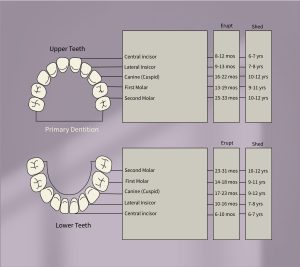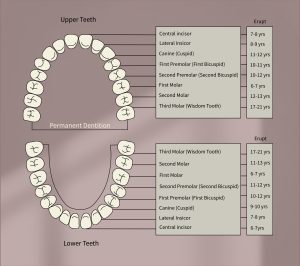Calgary Orthodontists Explain Tooth Numbers
Today i thought i would take you on a little journey through the very beginning of dental school when you learn how to number or count teeth.
All Calgary orthodontists will use this numbering system.
You’ve probably been sitting in the chair in our office at some point and heard Dr. Jen or Dr. Dena mutter something like “Oh there’s an open contact between the 3.3 and 3.4.”
Some of you have asked what we mean and we’ve explained it but I will give you the details now.
The way teeth are numbered in Canada, and it can be different in different places of the world, are by quadrant. Your upper right is the first quadrant, your upper left is the second quadrant, your lower left is the third quadrant, and your lower right is the fourth quadrant.
One, two, three, four.
From Front To Back – this is how orthodontists do it
The way we count the teeth is from the front going back. Your very front big tooth is number one. The rest follow… two, three, four, five, six, seven, and your wisdom tooth, if you have one, would be number eight.
It’s the same in each quadrant, so if I take a look at tooth number 1.6 it means we’re on the upper right and the sixth tooth back, which is the first molar. Your Calgary Orthodontists might be talking about this tooth because it is the one we look at most often to see if your bite is in the right place.
You’ll always hear the first number is where in your mouth it is, and the second number is which tooth it is in that area.
There is another set of numbers that we use if you still have baby teeth in your mouth.
This would apply to most children under the age of 12. Baby teeth are counted using different quadrant numbers. The upper right is 5, upper left is 6, lower left is 7 and lower right is 8. If we have baby teeth that are remaining on the upper right it would always start with a five and then the number of the tooth that goes in that order.
If you have a few teeth that are grown up teeth and a few teeth that are baby teeth on the upper right some of them will be called one-something and some of them will be called five-something and that is how we identify all the teeth in your mouth.

I hope you learned something new today!







